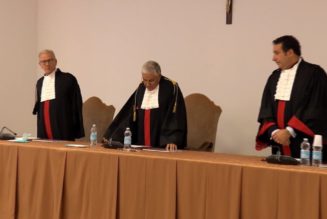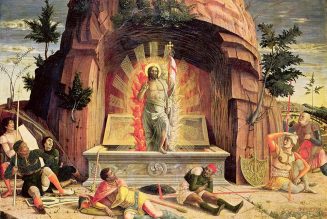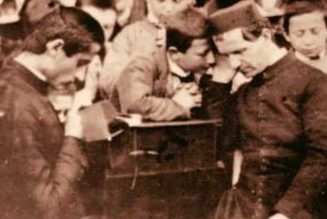
I was ordained a priest in 2002, on the day before the Sixteenth Sunday of the Year. At my first parish Mass that Sunday, the homilist—the masterful preacher Father Paul Holmes of Seton Hall University—told the people that this new priest was sent to preach the gospel to “congregations that are filled with wheat and weeds, with saints and sinners.” Not a world full of good and evil, but “congregations,” that is, the Church.
The parable of the wheat and the tares (Matthew 13:24–43) was read that Sunday, as it is every three years according to the lectionary cycle. So it was in 2002, and again this past Sunday, eighteen years on. “Tares” (or “darnel”) is a more suggestive translation than “weeds,” for the tares are often confused for wheat but are poisonous. They look healthy, but are corrupt within. The wheat and the tares grow side by side in the field, the wheat sown by the Lord, the tares by the devil.
Given the link to my own ordination, and my decades in Catholic journalism, I think about the wheat and the tares more than many of the other parables. This year, though, I have been thinking about the passage especially often.
My ordination took place several days before St. John Paul II arrived in Toronto for World Youth Day. Just a few hours’ drive away, our cathedral in Kingston was full that day with pilgrims from Poland and Chile. We were all on our way to Toronto. It was just months after the scandals in Boston had come to light. What would the Holy Father say? This great magnet for young Catholics would have to address the abuse of the young; the great champion of the heroic priesthood would have to speak about its corruption. The tares that had been growing alongside the wheat were now evident. We didn’t know then how abundant they were.
On May 18 of this year we celebrated the centennial of John Paul’s birth. But 2020 also marked the centennial of another priest, a centennial that was not observed in any way. Father Marcial Maciel, founder of the Legionaries of Christ, was born just two months before Karol Wojtyła, on March 10, 1920. The seeds of wheat and darnel were planted together.
I remember when I first learned that Wojtyła and Maciel were born the same year. It was May 2001, and Father Richard John Neuhaus and I were going to a lecture that he was giving at Regina Apostolorum, the Legionary university in Rome. The young Legionary accompanying us remarked upon the coincidence.
“1920 was a very good year,” Father Richard replied, adding that his late friend, Cardinal John O’Connor, was also born in 1920. A good year for good priests.
At the time, it was just a bit of trivia, like the fact that George W. Bush, then the newly-inaugurated president, was born the same year (1946) as his predecessor Bill Clinton. (Donald Trump is the third president born in 1946.) Later, the coincidence took on a new significance; I think about John Paul and Maciel whenever the parable of the wheat and the tares is read. For back in 1920, had anyone been able to see the seeds planted that year, he would have expected the abundant harvest to come from Maciel. Four of his uncles were bishops.
In May 2006, Benedict XVI concluded his investigation of Maciel, banishing him from all public ministry and sentencing him to a secluded life of penance. In October of that same year, Benedict canonized Maciel’s uncle, Bishop Rafael Guízar of Xalapa, Mexico. Persecuted during the Cristero period, Guízar had to flee his diocese. He spent the rest of his heroic ministry clandestinely in Mexico City. The wheat and the tares grew together in the same family.
St. John Paul was one of the most consequential popes in the long history of the Church. It is arguable that Maciel was the greatest fraudster in that same long history, one of the most devious and perverse clergymen to ever live. He was clever and cunning enough to fool a great many people, including John Paul himself, who regarded Maciel as a fellow stalk of wheat in the Lord’s harvest. He fooled Father Neuhaus as well as some of the wealthiest men in Mexico, who generally have experience dealing with corrupt and fraudulent men. He was even able to fool many of those who lived closest to him.
There is a famous photo of the two of them together, the wheat and the tares. Despite his advanced age, Maciel had been reluctant to step down as head of the Legionaries. Finally the Vatican prevailed upon him to leave, and called a general chapter for January 2005 to elect his successor. John Paul gave Maciel a favorable send-off in November 2004; the photo from the occasion depicts one old man blessing another. Even then, the tares looked like the wheat.
Harvest time came. Cardinal Joseph Ratzinger, taking advantage of Maciel’s retirement and reduced influence, reopened the investigation. In 2005 Ratzinger was elected pope and in 2006 he banished Maciel, who died in 2008. In 2009, his secret life was publicly revealed. In 2010, a special Vatican visitation concluded that Maciel was guilty of “true crimes and manifest[ed] a life without scruples or authentic religious sentiment.” In 2019, the Legionaries calculated that he had sexually abused more than 60 young men, including his own illegitimate children.
That good and evil exist side by side is not really news, and is not the meaning of the parable of the wheat and tares. The meaning is that they are so intertwined that sometimes it is hard to recognize which is which. St. John Paul spoke of priestly sexual abuse as a manifestation of the mysterium iniquitatis, the profound mystery of how evil exists in a world made good by God. The parable addresses that, but also a more ordinary sense of the word “mystery.” We simply do not know fully what is going on around us. In that latter sense, it was only in the late evening of life that the mystery of Maciel came to light.
Like many priests of my age—the John Paul II generation—I have many cherished memories and images of the saintly pope. But I especially strive to remember that unhappy image of John Paul and Maciel, as a reminder that in the field of the Church the wheat and the tares are always with us. That mystery, and lesser mysteries, always await the light.
Raymond J. de Souza is a priest in the archdiocese of Kingston, Ontario.
First Things depends on its subscribers and supporters. Join the conversation and make a contribution today.
Click here to make a donation.
Click here to subscribe to First Things.









